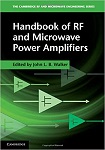RF and Microwave Power Amplifiers
|
|
Click here for the complete list of RF Cafe Quizzes. Note: Some material based on books have quoted passages. This quiz is based on the information presented in Handbook of RF and Microwave Power Amplifiers, by John L. B. Walker. Cambridge University Press graciously provided the book.
Whether you are an RF transistor designer, an amplifier designer or a system designer, this is your one-stop guide to RF and microwave transistor power amplifiers. A team of expert authors brings you up to speed on every topic, including: devices (Si LDMOS and VDMOS, GaAs FETs, GaN HEMTs), circuit and amplifier design (discrete, hybrid and monolithic), CAD, thermal design, reliability, and system applications/requirements for RF and microwave transistor amplifiers. Covering state-of-the-art developments and emphasizing practical communications applications, this is the complete professional reference on the subject. 1. What are the two primary parasitic components of a ceramic package for an RF power amplifier? c) Lead frame capacitance and wire bond inductance As a first-order approximation the lead frame parasitic capacitance can be combined with the wire bond inductance to realize a transmission line of characteristic impedance of 50Ω. (see page 397)
2. What change to coaxial connectors is necessary to accommodate higher frequencies? a) Physical size decreases To make connectors function at higher frequencies the size is decreased... (see page 311)
3. What are the ramifications of the results of Question 2? c) Power handling decreases ...this reduces both the current handling and the voltage breakdown, thus reducing the power handling capabilities. (see page 312)
4. What is(are) the broad class(es) of RF power transistor(s)? d) All the above There are three broad classes of RF power transistors: BJTs, MOSFETs (vertically and laterally diffused, VDMOS, LDMOS), and gallium devices with arsenide and nitride (GaAs and GaN). (see page 249)
5. How is the average efficiency of a Class B amplifier affected by power back-off? a) Degrades as the square root of the power back-off level The average efficiency of a Class B amplifier degrades by the square root of the power back-off level. (see page 561)
6. What breakdown condition(s) is(are) typically specified for FETs? d) All the above The three breakdown voltages generally quoted for FETs are the gate-source (BVgs), the gate-drain (BVgd), and the drain-source (BVds). (see page 57)
7. How is the crest factor (CF) related to peak signal-power-to-average-signal-power (PAPR)? a) CF = √(PAPR) Crest factor (CF) is the square root of the peak signal-power-to-average-signal-power (PAPR) (see page 513)
8. What is the primary limitation of RF power transistor applications? b) Parasitic elements In RF power applications, the operational effectiveness (e.g., gain, power density, efficiency, etc.) of a transistor is mostly limited by its parasitic elements. (see page 12)
9. What is a fundamental problem with using Newton's Method in a harmonic-balance simulation? c) Newton's Method is not guaranteed to converge on a solution If the initial value is not properly chosen, Newton's Method could fail to converge on a solution. (see page 194)
10. What is a limitation on RF power amplifier (RFPA) design margin requirements? a) Test equipment precision and accuracy How accurately the test results are acquired will ultimately advise the RFPA engineer of how much design margin does/doesn't exist. (see page 268)
Posted January 19, 2022 |

